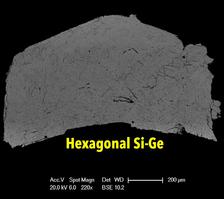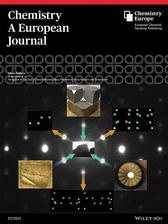Backscattered electron microscopy image of a recovered Si-Ge sample with bulk composition Si:0.22Ge:0.78 at% after heating a 25:75 at% Si:Ge mixture at 17 GPa at 1473 K for two minutes followed by annealing at 800 K for 2.5 hours and subsequent temperature quenching and decompression to ambient pressure. Angle dispersive X-ray diffraction measurements from this sample were performed at PETRA III beamline P02.2. (Credit: George Serghiou, University of Edinburgh)
A team of scientists from European and US research institutions have succeeded in synthesizing and characterizing a complete new bulk Si-Ge materials landscape, important for optoelectronic applications. The conditions under which each composition of this new materials landscape is formed, pressures of between 12 and 17 GPa and temperatures of 1500–1800 K, are reported in 'Chemistry – A European Journal'.
Two fundamental conduits of information are electrons and photons. A central challenge for decades has been to develop a seamless communication between these two conduits. Cubic diamond-structured semiconducting silicon (Si) has been the material driver of the electronics industry since its inception. This Si, ubiquitous in electronic devices, is hence the electronic conduit par excellence. It is however a very inefficient interconverter of electricity and light, due to its indirect band-gap.
Two crucial criteria hence need to be met by a material if a seamless communication between electrons and photons is to be achieved in devices. The material needs to exhibit a direct band-gap so that interconversion between electricity and light is efficient, and it must be compatible with Si. The goal is to produce bulk hexagonal SiGe alloys which have a direct band-gap and would satisfy the criteria.
In a recent study 0.5 micron thick hex-SiGe nanowires templated on GaAs nanowire cores were produced exhibiting a tunable direct band-gap as a function of the composition. Together with another recent study (Emerging Light‐Emitting Materials for Photonic Integration), those results strongly emphasize the pressing need to develop un-templated bulk hex-SiGe, rid of foreign substrates. This then would allow hex-SiGe to be integrated seamlessly with Si on the same chip allowing efficient communication between electrons and photons.
In this high pressure and temperature study using frontline synthetic and characterization methods, namely laser-heated diamond anvil and scale-up large volume press methods in conjunction with precession electron diffraction, synchrotron angle dispersive X-ray diffraction with characterization measurements at PETRA III beamline P02.2 and electron microscopy, they developed a new bulk un-templated hexagonal SiGe landscape. Moreover, they have explained exactly how and under what conditions each and every SixGe1-x composition (0 < x < 1) becomes hexagonal. Additionally, they have succeeded in producing three different hexagonal SiGe polytypes. This is also new since the band-gap is tunable not only as a function of composition but as a function of the stacking sequence as well.
Noteworthy is that high pressure chemistry has previously produced the highest quality crystals of another optoelectronically important crystal, GaN, used subsequently both as is and as an optimal substrate for deposition. Here there is a further advance, while GaN existed in the bulk even then, hexagonal SiGe is only made possible now, through the chemical reaction route of this contribution. This may pave the way to future optoelectronics applications.
Original publications:
Hexagonal Si-Ge Class of Semiconducting Alloys Prepared Using Pressure and Temperature, George Serghiou, Nicholas Odling, Hans Josef Reichmann, Gang Ji, Monika Koch-Müller, Daniel J. Frost, Jonathan P. Wright, Reinhard Boehler and Wolfgang Morgenroth, Chem. Eur. J. (2021); DOI: 10.1002/chem.202102595 (Cover Feature)








